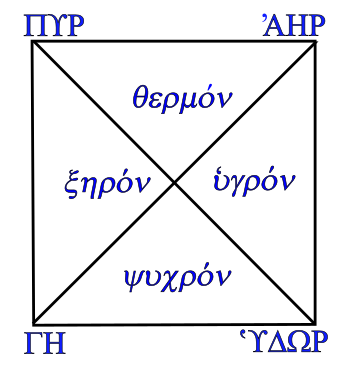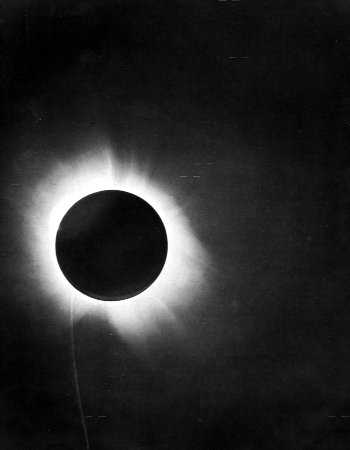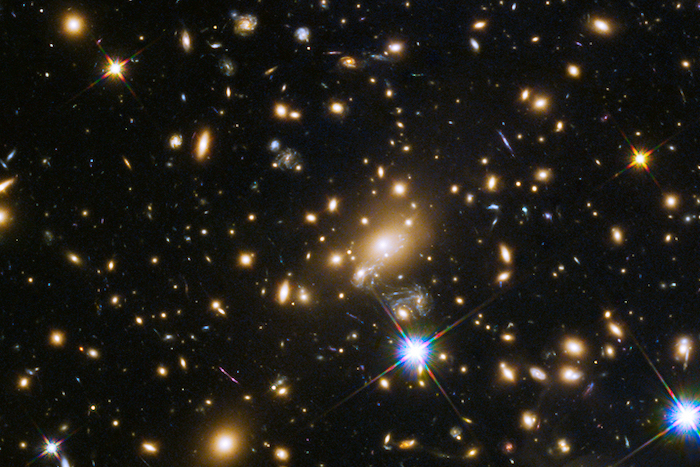Gravitational Lensing
July 10, 2023
The
ancient Greek philosopher,
Aristotle (384-322 BC), had an interesting
explanation of
gravity. In
Aristotelian physics, all things were
composed of the
four essential elements,
Earth (Γη),
Air (ʾΑηρ),
Fire (Πυρ), and
Water (ʿΥδωρ). In the absence of any
holding force, these elements had a tendency to go to their
natural place. The natural place of the Earth element is the
center of the universe. According to his
geocentric cosmology, this was the
center of the Earth; so,
matter falls down. Likewise, the lightest elements, air and fire, move away from the geocenter to their natural places in the
heavens.

The four classical elements, Earth (ΓΗ), Air (ʾΑΗΡ), Fire (ΠΥΡ), and Water (ʿΥΔΩΡ).
Aristotle, in his On Generation and Corruption, associated each of the four elements with two sensible qualities; namely, Dry (ξηρον), Wet (ʿυγρον), Hot (θερμον), and Cold (ψυχρον).
Earth is both cold and dry, Air is both hot and wet, Fire is both hot and dry, and water is both cold and wet.
(Created using Inkscape. Click for larger image.)
The particular physical properties of a
composite material, including its
gravitational attraction, derive from the
proportion of these four elements in its composition. Aristotle believed in the
logical idea that heavier objects fall more rapidly.
Galileo's experiments demonstrated that the
mass of an object did not affect its
gravitational acceleration towards Earth, and
Isaac Newton discovered his
inverse-square law describing gravitational attraction. I should emphasize that Newton
described gravity, he didn't
explain gravity in the sense that Aristotle did. As Newton himself wrote in the 2nd
edition of the
Principia,
hypotheses non fingo (I frame no hypotheses).
Albert Einstein's 1913 theory of
general relativity actually explained gravity as the
curvature of
four dimensional space-time being
proportional to an object's mass.[1] Theory is one thing, but every
scientist desires that his theory be confirmed by experiment. Einstein proposed three experimental
tests of general relativity; namely, the
perihelion precession of Mercury's orbit, the
deflection of light by the Sun, and the
gravitational redshift of light. All of these were difficult measurements. The predicted advance of the perihelion of Mercury was 43.03
arcsec/
century, and the bending of light around the
Sun was predicted to be 1.75 arcsec.[2]

Positive image of the Solar eclipse of May 29, 1919, a measurement by Arthur Eddington (1882-1944) that verified general relativity.[3]
Eddington needed to wait until the end of the World War I to make this observation. He traveled to the island of Príncipe at the west coast of Africa and photographed this solar eclipse and the surrounding stars in the Hyades cluster and the constellation, Taurus.
This was an observation that made front page headlines in newspapers.[4]
(Wikimedia Commons image from ref. 3.[3] Click for larger image.)
As I've written time and again, science advances in step with advances in
scientific instrumentation. This concept is especially true for
observational astronomy as it advanced from Galileo's
telescope to today's
James Webb Space Telescope. When the
gravity well is a
galaxy with more than a trillion times the mass of the Sun, there's enough bending of light to create multiple images of background objects by
gravitational lensing. Gravitational lensing was first observed in 1979 with the discovery of identical
quasi-stellar objects, so named since they appeared as mysterious point objects of high
luminosity, but are now known to be
active galactic nuclei.[5] This
Twin Quasar SBS 0957+561 is actually a single
quasar whose light was bent into two images by a galaxy between it and the Earth.
.jpg)
An example of gravitational lensing producing a nearly contiguous ring of light.
In this case, the gravity of LRG 3-757, a luminous red galaxy, has lensed the light from a more distant blue galaxy. The blue galaxy, LRG 3-757, and Earth are so precisely aligned that a ring results, rather than multiple images.
(Wikimedia Commons image, a portion of a ESA/Hubble & NASA image. Click for larger image.)
Gravitational lensing has a use beyond a proof of general relativity. The
Hubble constant, which specifies the rate of
universal expansion, has been determined by two principal methods. There's observations of the nearby
supernovae. The other is by observation of the
cosmic microwave background. These methods give a value of the Hubble constant that differs by about 10%, leading to a problem for cosmology known as the
Hubble tension. Gravitational lensing leads to another way to measure this constant. As
Patrick Kelly, an
assistant professor at the
University of Minnesota and lead
author of a
study on this method,[6-9] explains, "Our research addresses that by using an independent, completely different way to measure the expansion rate of the Universe."[9]
Gravitation lensing will produce multiple images of a supernova, the light from each image traveling to Earth along a different path, so each arrives at a different time.[8] In 1964,
Norwegian astronomer,
Sjur Refsdal (1935-2009),
theorized that this
phenomenon could be used to measure the Hubble constant.[7-9] Fifty years later, in December, 2014, the
Hubble Space Telescope imaged four lensed images of the same supernova.[8] This supernova (
redshift, z = 1.49) is far behind the lensing
cluster of galaxies, which itself is distant (z = 0.54).[7] It was predicted that another image would appear, and it did after 376 days.[8]

The gravitationally lensed supernova image. An annotated image appears in ref. 8.[8]
(University of Minnesota image by Patrick Kelly.[9] Click for larger image.)
Says Kelly, "It's advantageous to have a year-long delay, because the value of the Hubble constant is
inversely proportional to the time delay."[8] The inferred Hubble constant based on this delay was lower than that
calculated from observations of
Cepheid variables and on other luminosity distance markers.[8] It was 64.8 (- 4.3 + 4.4)
km/sec/
megaparsec.[6] The
errors relate to the
estimate of the path length based on
models of the mass
distribution of the lensing galaxy, including the contribution from unobservable
dark matter.[8] The measurement is at the low end of the Hubble tension range, but the 6% error puts it close to the the other values.[8]
The errors would be reduced by a better model of the mass distribution of the lensing galaxy cluster, something that could be done with the new
James Webb Space Telescope.[8] Further examples of this effect would help.[8] As Kelly summarizes,
"Our measurement is in better agreement with the value from the cosmic microwave background, although — given the uncertainties - it does not rule out the measurement from the local distance ladder... If observations of future supernovae that are also gravitationally lensed by clusters yield a similar result, then it would identify an issue with the current supernova value, or our understanding of galaxy-cluster dark matter."[9]
Funding for this
research was provided by
NASA through the
Space Telescope Science Institute, and by the
National Science Foundation.[9]
References:
- English translation of Marcel Grossmann and Einstein, "Entwurf einer verallgemeinerten Relativitätstheorie und einer Theorie der Gravitation (Outline of a Generalized Theory of Relativity and of a Theory of Gravitation)," Zeitschrift für Mathematik und Physik, vol. 62 (1913), pp. 225-261 (PDF file, via the University of Pittsburgh).
- Estelle Asmodelle, "Tests of General Relativity: A Review," arXiv, May 11, 2017, https://doi.org/10.48550/arXiv.1705.04397.
- Frank Watson Dyson, Arthur Stanley Eddington, and C. Davidson, "A Determination of the Deflection of Light by the Sun's Gravitational Field, from Observations Made at the Solar eclipse of May 29, 1919," Philosophical Transactions of the Royal Society, vol. A. 220, no. 571–581 (January 1, 1920), pp. 291-333, https://doi.org/10.1098/rsta.1920.0009.
- Robin McKie, "100 years on: the pictures that changed our view of the universe," The Guardian (UK), May 12, 2019.
- D. Walsh, R. F. Carswell, and R. J. Weymann, "0957 + 561 A, B: twin quasistellar objects or gravitational lens?," Nature vol. 279, May 1, 1980, pp. 381-384, https://doi.org/10.1038/279381a0.
- Patrick L. Kelly, Steven Rodney, Tommaso Treu, Masamune Oguri, Wenlei Chen, Adi Zitrin, Simon Birrer, Vivien Bonvin, Luc Dessart, Jose M. Diego, Alexei V. Filippenko, Ryan J. Foley, Daniel Gilman, Jens Hjorth, Mathilde Jauzac, Kaisey Mande, Martin Millon, Justin Pierel, Keren Sharon, Stephen Thorp, Liliya Williams, Tom Broadhurst, Alan Dressler, Or Graur, Saurabh Jha, Curtis McCully, Marc Postman, Kasper Borello Schmidt, Brad E. Tucker, and Anja von der Linden, "Constraints on the Hubble constant from Supernova Refsdal's reappearance," Science (First Release, May 11, 2023), DOI: 10.1126/science.abh1322.
- Patrick L. Kelly, Steven A. Rodney, Tommaso Treu, Ryan J. Foley, Gabriel Brammer, Kasper B. Schmidt, Adi Zitrin, Alessandro Sonnenfeld, Louis-Gregory Strolger, Or Graur, Alexei V. Filippenko, Saurabh W. Jha, Adam G. Riess, Marusa Bradac, Benjamin J. Weiner, Daniel Scolnic, Matthew A. Malkan, Anja von der Linden, Michele Trenti, Jens Hjorth, Raphael Gavazzi, Adriano Fontana, Julian C. Merten, Curtis McCully, Tucker Jones, Marc Postman, Alan Dressler, Brandon Patel, S. Bradley Cenko, Melissa L. Graham, and Bradley E. Tucker, "Multiple images of a highly magnified supernova formed by an early-type cluster galaxy lens," Science, vol. 347, no. 6226 (March 6, 2015), pp. 1123-1126, DOI: 10.1126/science.aaa3350.
- Michael Schirber, "Measuring Cosmic Expansion with a Lensed Supernova," Physics, vol. 16, no. 85 (May 18, 2023).
- First-of-its-kind measurement of Universe’s expansion rate weighs in on longstanding astronomy debate, University of Minnesota Press Release, May 11, 2023.
Linked Keywords: Ancient Greek philosophy; ancient Greek philosopher; Aristotle (384-322 BC); theory; explanation; gravity; Aristotelian physics; composite material; composed; classical element; four essential elements; Earth (classical element); Γη; Air (classical element); ʾΑηρ; Fire (classical element); Πυρ; Water (classical element); ʿΥδωρ; holding force; natural place; center of the universe; geocentric model; cosmology; inner core; center of the Earth; matter; celestial sphere; heavens; four qualities of matter; On Generation and Corruption; sense; sensible; quality (philosophy); arid; dry; humidity; wet; heat; hot; cold; Inkscape; gravity; gravitational attraction; proportionality (mathematics); logic; logical idea; Galileo Galilei; experiment; mass; gravitational acceleration; Isaac Newton; Newton's law of universal gravitation; inverse-square law; edition (book); Philosophiae Naturalis Principia Mathematica; hypotheses non fingo (I frame no hypotheses); Albert Einstein; general relativity; curvature; four dimensional; spacetime; space-time; scientist; tests of general relativity; perihelion precession of Mercury; deflection of light by the Sun; gravitational redshift of light; minute of arc; arcsec; century; Sun; Solar eclipse of May 29, 1919; positive (photography); photograph; image; Solar eclipse; Arthur Eddington (1882-1944); experimental verification; World War I; observational astronomy; island; Príncipe; Gulf of Guinea; west coast of Africa; star; Hyades (star cluster); constellation; Taurus (constellation); front page; headline; newspaper; Wikimedia Commons; scientific instrument; scientific instrumentation; optical telescope; James Webb Space Telescope; Hill sphere; gravity well; galaxy; gravitational lens; gravitational lensing; quasar; quasi-stellar object; luminosity; active galactic nucleus; Twin Quasar SBS 0957+561; Einstein ring; contiguous; ring; light; cosmic Horseshoe; LRG 3-757; luminous red galaxy; Earth; angle; aligned; Hubble's law; Hubble constant; expansion of the universe; universal expansion; supernova; supernovae; cosmic microwave background; Hubble tension; Patrick Kelly; assistant professor; University of Minnesota; author; scientific study; Norway; Norwegian; astronomer; Sjur Refsdal (1935-2009); theoretical physics; theorize; phenomenon; Hubble Space Telescope; redshift, z; galaxy cluster; cluster of galaxies; Supernova 2014; digital imaging; annotation; annotated; multiplicative inverse; calculation; calculated; Cepheid variable; kilometers per second; km/sec; parsec; megaparsec; measurement uncertainty; error; estimation; estimate; physical model; frequency distribution; dark matter; funding of science; research; NASA; Space Telescope Science Institute; National Science Foundation.